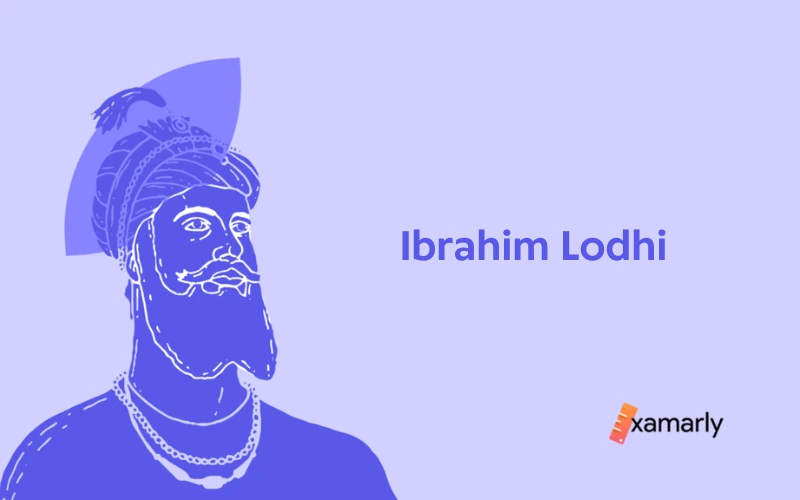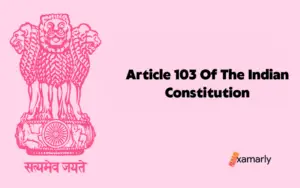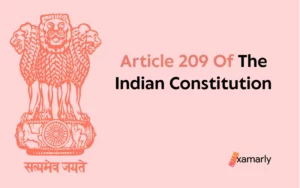Ibrahim Lodi was the last Sultan to rule the Delhi Sultanate under Lodi Dynasty. His rule is considered the worst in the long line of rulers of the dynasty, fraught with mass dissatisfaction among the nobles, and riots among the common people.
His cruel nature and attitude towards nobility did nothing to quell the fire that was ignited upon his succession to the throne.
This article discusses the legacy of Ibrahim Lodhi. Read it to learn more about him. This will be beneficial for the candidates preparing for the UPSC Exam.
This section is a part of the Medival History of UPSC Syllabus. Also, read about the Delhi Sultanate Administration.
Ibrahim Lodhi: An introduction
Ibrahim Khan Lodi of the Lodi dynasty succeeded his father Sikander Lodhi. He was the last Afghan to dominate India. He ruled for barely nine years (1517–1526) since he was not looked kindly upon by the subjects of his inheritance.
His lack of ability to rule, added to the fact that he did not get along with nobility made him unpopular even among his own ministers. The strife he caused was so great that one of his own noblemen invited Babur to replace him as the ruler.
His defeat in the First Battle of Panipat, marked the beginning of Mughal authority in India.
Related Reading: Bahlul Lodi: First Sultan of the Lodi Dynasty
Reign
- The death of Sikander Lodi saw the ascension of his eldest son, Ibrahim Khan Lodi, to the throne. His coronation took place in Agra, Uttar Pradesh in 1517. He faced resistance from a faction of the nobility.
- Ibrahim’s cruel nature and prejudice toward nobility made him unfavored to the point that the nobles and some of his ministers arranged for a partition of the kingdom to set up his younger brother, Jalal Khan.
- Ibrahim allowed Jalal to rule Jaunpur as an independent ruler, even after many warnings from his ministers who advised him against doing so, as the ministers did not like the idea of two brothers ruling the same kingdom.
- He heard of Jalal’s misuse of the power given to him. As a result of this, he sent secret instructions to the chiefs, nobles, and governors to disregard Jalal Khan’s authority as a ruler.
- Upon the refusal of his subjects to recognize him as their ruler, Jalal Khan was forced to leave Jaunpur and return to Kalpi. However, he managed to recover Awadh shortly after.
- This, however, did not sit well with Ibrahim, so he sent assassins to kill Jalal and claim the entire kingdom for himself.
- After having the entire kingdom to himself, his incapability as a ruler was glaringly obvious with the fact that riots and unrest became a widespread phenomenon, and his own ministers and nobles started to fear for their lives.
- Rana Sangram Singh (also known as Rana Sanga), the ruler of Mewar, had expanded his own empire to the Western border of Uttar Pradesh and threatened to attack Agra, which would have led to a war between the two kingdoms.
- It was this very fear that led Daulat Khan, one of the noblemen of the court of Ibrahim Lodi, to invite Babur to invade and unsettle Ibrahim’s rule.
- Rana Sangram Singh also did the same so that Babur would invade India and Rana Sanga could rule over Delhi.
- Babur, a descendant of Chengiz Khan, and the Mughal ruler of Kabul accepted the invitation and battled Ibrahim, in the First Battle of Panipat.
Traits
- Ibrahim Lodi was a very ego-driven and cruel ruler among the other rulers of the Lodi Dynasty.
- This ruler of the Lodi Dynasty was known for his atrocities.
- It has been noted that Ibrahim Lodi could not build good relationships with the nobles of his royal court.
- During the reign of Ibrahim Lodi, it was common for nobles to be caught and imprisoned.
The First Battle of Panipat
- Babur, who ruled over Fergana (now in Uzbekistan), overthrew Kabul in 1504. He was both Timur and Genghis Khan’s ancestor.
- He made three attempts to take Samarkand, all of which were unsuccessful. He consequently turned his attention to Punjab.
- Ibrahim Lodhi of the Lodi dynasty dominated North India at the time, but the empire was disintegrating and there were several defectors.
- Daulat Khan, and Ala-ud-Din Lodi, uncle of Ibrahim Lodi, feared Ibrahim to the point that they invited Babur to invade the kingdom and uproot Ibrahim Lodi. Daulat Khan was the governor of Punjab at that time.
- When Babur received the invitation, he sent an ambassador to Ibrahim, proclaiming himself to be the legitimate heir to the throne of the empire. However, the diplomat was held in Lahore and freed many months later.
- Babur came to Lahore in 1524 but was driven away by Lodi’s forces. With the aid of a different rebel chief, he made another futile attempt to defeat Lodi.
- However, a more effective intelligence network in 1526 allowed Babur to be more ready.
- This led to the First Battle of Panipat, which was fought there in 1526. Panipat is a level plain appropriate for cavalry manoeuvres located about 50 miles (80 km) north of Delhi.
Army of Both Sides
- In the First Battle of Panipat, Babur’s army consisted of between 20 to 24 cannons and between 12,000 to 25,000 soldiers, which were mainly horse cavalry.
- While Ibrahim Lodhi’s army comprised 50,000 to 120,000 troops, as well as 400 to 1,000 war elephants.
- Even though Ibrahim Khan had a much larger army, Babur managed his smaller forces in battle formations that were unseen in battles.
- The formations, with the use of firearms, proved to be deadly and efficient, killing over 20,000 men, and crippling Ibrahim’s army.
The Decline of Ibrahim Lodi
- Ibrahim Khan Lodhi persevered in his position as the Sultan of Delhi by removing a large portion of his kingdom.
- His cruel nature and his general dislike towards noblemen made him an unpopular ruler in his own court.
- The replacement of experienced and senior commanders with younger ones devoted to him served to anger both the army and the nobility.
- His inability in ruling the kingdom, and his cruelty towards those who dared to bring this to his attention led his uncle, Ala-ud-Din Lodi, and Daulat Khan, one of the noblemen and the governor of Punjab to invite Babur to invade India and remove Ibrahim from the throne.
- Ibrahim Lodhi’s underestimation of the enemy’s forces and the lack of modern firepower in his own army led to his defeat in the First Battle of Panipat in 1526, even though his army largely outnumbered Babur’s Mughal forces.
Reason behind his downfall
- The downfall of Ibrahim Lodi’s empire began on the day he became king, his inability to form plans for the benefit of his kingdom, added to his cruel nature and lack of understanding of political concepts resulting in an empire in which riots and discontent were found everywhere.
- Due to his failure to establish an efficient administrative system, trade routes were blocked, which caused many trade routes to degenerate.
- Even after trying really hard to keep his throne, his ego led him to underestimate his opponent Babur, which led to his death and defeat in the First Battle of Panipat.
- Ibrahim, even after having the advantage of much greater numbers in his army and being on his home territory was defeated by the much smaller army of Babur as he severely underestimated the advantage of the technologically advanced guns in Babur’s army.
- After having over 20,000 of his men killed on the battlefield and having many more wounded and captured, he realized his lapse in judgment and faced Babur with his army once again.
- Ibrahim Lodhi was killed on the battlefield of Panipat on April 21, 1526, marking the end of his dynasty.
Tomb of Ibrahim Lodi
The tomb of Ibrahim Lodhi is a rectangular open grave built on a raised platform, made of Lakhauri bricks.
The historical tomb serves as the final resting place of Ibrahim Khan Lodhi. An inscription situated nearby informs that the tomb had to be relocated in 1867, by the British government for the construction of the grand trunk road in Northern India.
The tomb, maintained by the Panipat Municipal Corporation, is situated in a park near the dargah of the Sufi Saint Bu Ali Shah.
It holds no architectural significance, instead, it marks the broader historical significance of the city.
You Might Also Like: Delhi Sultanate Questions and Answers for UPSC
Conclusion
In this blog for UPSC preparation, you learnt about the life and reign of Ibrahim Lodi (also known as Ibrahim Khan). Born in 1480 AD to Sikandar Lodi, the most successful ruler of the Lodi dynasty, Ibrahim Lodi’s rule can be simply described as the exact opposite of his father.
Ibrahim was influenced by his Afghan blood to choose Islam as his religion but is described by historians as the worst religious thinker of the Lodi dynasty.
Although he was the one chosen for succession, his rule and general attitude toward nobility led his own people to conspire to make his younger brother gain power in the kingdom.
Even though his personality and lack of ruling capability made him the worst ruler of the Lodi dynasty, his acts on the battlefield led to him being called a brave warrior and general to have led his army from the front lines.
His death at the hands of Babur marked the end of the Lodi dynasty, and the beginning of a 331-year-long Mughal rule, which would then be followed by the British Raj.
FAQs
Who was Ibrahim Lodhi?
Ibrahim Lodhi was the last ruler of the Delhi Sultanate. He ruled from 1517 to 1526.
What was his reign like?
Ibrahim Lodhi’s reign was marked by political instability and military conflicts. He faced numerous rebellions and was unable to maintain control over his kingdom.
What led to his downfall?
Ibrahim Lodhi’s downfall was due to his defeat at the Battle of Panipat in 1526, where he faced off against the Mughal Empire’s founder, Babur.
What was Ibrahim Lodhi’s legacy?
Ibrahim Lodhi is remembered for his bravery and his tragic defeat at the Battle of Panipat, which marked the end of the Delhi Sultanate and the beginning of the Mughal Empire.
What were Ibrahim Lodhi’s achievements?
Ibrahim Lodhi did not have any notable achievements during his reign as the Sultan of Delhi due to his inability to maintain control over his kingdom.






